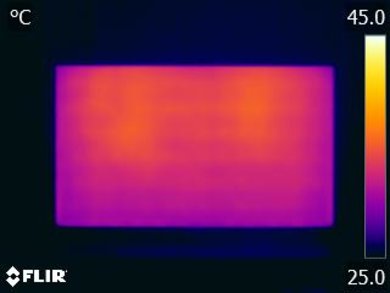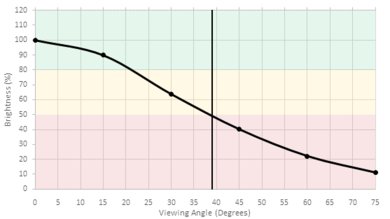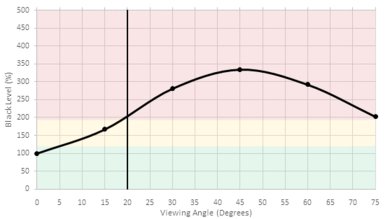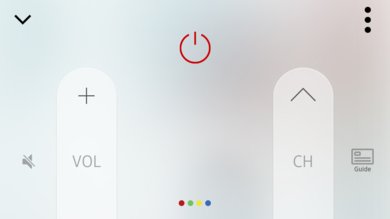The Samsung MU6290 is an entry-level 4K smart LCD TV. It's quite versatile thanks in part to its high contrast which gives it decent picture quality in a dark room. Its input lag is also quite low, making it a good choice for gaming. Unfortunately, its picture quality is greatly reduced when viewed at an angle, and it lacks support for modern features like a wide color gamut and local dimming.
Our Verdict
Average TV for a mixed usage. The Samsung MU6290 does most tasks decently; its picture quality is decent, its input lag is low, and it doesn't produce an immense amount of input lag. Most people will be quite pleased by its smart features as well. Where it falls short is its lack of fancier feature such as HDR and local dimming.
-
Good contrast for dark room viewing
-
Low input lag for gaming
-
Image quality deteriorates at an angle
-
Limited HDR capabilities
Passable choice for watching movies. While the MU6290's high contrast and uniform blacks give its image a lot of depth in a dark room, it does lacks the local dimming feature required to produce even deeper blacks. Unfortunately, it also cannot display 24p content without judder, but this is only an issue for those sensitive to it.
Decent TV for watching TV shows in a bright room. The MU6290 features a slick and intuitive smart platform that makes it easy to access popular apps. It also gets decently bright in SDR, so it should suit most viewing environments.
The MU6290 is about average for sports watching. It can get bright enough, and its screen doesn't have any major uniformity issues, but its motion performance is a bit ordinary causing some trailing behind moving objects. Unfortunately, its limited viewing angle also means the picture will look significantly worse to people watching from the sides.
Good TV for playing video games. The MU6290's very low input lag keeps it responsive. While not great, its low amounts of motion blur keep fast-paced shooters or fighting game quite clear.
Below average TV for HDR movies. The MU6290 does support HDR10, but it lacks most of the features associated with it that enable TVs to enhance the image quality. Its peak brightness is also not high enough to create a significant HDR effect.
Good TV for HDR gaming. While the MU6290's HDR presentation isn't stellar, there is no downside to using an HDR input for gaming. Its input lag remains low, and the image stays quite bright.
Average PC monitor. The MU6290 supports Chroma 4:4:4 which is essential, but its average motion blur can be quite distracting for scrolling text. It also does not support a 1080p@120Hz input for PC gaming. Fortunately, image retention is not present.
- 7.3 Mixed Usage
- 6.6 Movies
- 7.4 TV Shows
- 7.1 Sports
- 8.1 Video Games
- 6.6 HDR Movies
- 7.6 HDR Gaming
- 7.8 PC Monitor
Changelog
- Updated Mar 12, 2018: Converted to Test Bench 1.2.
- Updated Jan 05, 2018: Bluetooth can be enabled in the TV's service menu, allowing the use of the Samsung smart remote (not included) and its voice control, as well as Bluetooth headphones.
- Updated Dec 25, 2017: Review published.
- Updated Dec 23, 2017: Our testers have started testing this product.
- Updated Dec 23, 2017: Early access published.
Check Price
Differences Between Sizes And Variants
We tested the 55" (UN55MU6290) version CC09. For the most part, we expect our review to be valid for the other sizes of this model.
The 43" size likely uses an IPS-type panel, according to many user reports, so our review is not a good indication of this size's performance. An IPS-type panel will have a much worse contrast ratio but a much better viewing angle than the VA panel unit we tested, which will change our overall scores significantly.
The MU6290 is almost identical to the pricier Samsung MU6300. The biggest difference between the two is the Bluetooth connectivity found on the more expensive variant and fancy smart remote.
If someone comes across a different type of panel or if their Samsung MU6290 doesn't correspond to our review, let us know and we will update the review.
| Size | LCD Type | Model | US | US Alternate | Canada |
| 40" | VA | UN40MU6290 | UN40MU6290FXZA | 40MU6290FXZA | UN40MU6290FXZC |
| 43" | IPS | UN43MU6290 | UN43MU6290FXZA | 43MU6290FXZA | UN43MU6290FXZC |
| 49" | VA | UN49MU6290 | UN49MU6290FXZA | 49MU6290FXZA | UN49MU6290FXZC |
| 55" | VA | UN55MU6290 | UN55MU6290FXZA | 55MU6290FXZA | UN55MU6290FXZC |
| 65" | VA | UN65MU6290 | UN65MU6290FXZA | 65MU6290FXZA | UN65MU6290FXZC |
| 75" | VA | UN75MU6290 | UN75MU6290FXZA | 75MU6290FXZA | UN75MU6290FXZC |
Popular TVs Comparisons
Much like the MU6300, the Samsung MU6290 is somewhat of a jack of all trades. It will work well enough in a variety of usages, but it also won't excel in any of them.
The Samsung MU6300 and the Samsung MU6290 perform very similarly, and there is no significant difference between the two. The Samsung MU6300 supports Bluetooth out of the box. Bluetooth is not officially supported by the MU6290, although for some sizes this can be enabled through the service menu, as described here.
The Samsung MU6290 is better than the LG UJ6300 for most people, unless you have a wide sitting area. The Samsung MU6290 has a VA panel which is better suited for viewing in a darker room from a direct viewing position, thanks to the much higher native contrast ratio and excellent black uniformity. The LG UJ6300 has an IPS type panel which is better suited for a wide sitting area in a brighter room thanks to the better viewing angles and great reflection handling.
The TCL S405 and Samsung MU6290 deliver very similar performance overall. The TCL S405 has a better response time and can remove judder from most 24p sources. The Samsung MU6290 is much brighter and has more options for smoothing out motion, including optional motion interpolation and a better black frame insertion feature, but can't remove judder from 24p sources.
The Samsung NU7100 4k TV is slightly better than the Samsung MU6290. The NU7100 has better gray uniformity and better reflection handling, good for sports fans watching the big game on a Sunday afternoon. The NU7100 also has better input lag for gamers or use as a PC monitor. The Samsung MU6290 is a bit brighter with SDR content.

We buy and test dozens of TVs yearly, taking an objective, data-driven approach to deliver results you can trust. Our testing process is complex, with hundreds of individual tests that take over a week to complete. Most of our tests are done with specially designed test patterns that mimic real content, but we also use the same sources you have at home to ensure our results match the real-world experience. We use two main tools for our testing: a Colorimetry Research CR-100 colorimeter and a CR-250 spectroradiometer.
Test Results
The V-shaped stand of the Samsung MU6290 has quite a small footprint but still supports the TV well. The plastic connection between the stand and the rear of the TV has some flex, so the TV will wobble a bit if knocked. It appears identical to the MU6300.
Footprint of the 55" TV stand: 12.1" x 33.2"
The Samsung MU6290 has a great contrast ratio. when set in a dark room, it can display really deep black, which in turn are especially good for dark scenes in movies. This is a stark contrast to what you see on IPS TV with lower contrast ratio, as they can't reproduce deep blacks and dark scenes look more washed out.
The Samsung MU6290 does not have a local dimming feature. The video is for reference only.
Good SDR peak brightness, good enough for a fairly bright room. The brightness remains very consistent except when showing very dark scenes (demonstrated by our 2% window test); that's when the TV's CE dimming takes effect and dims the whole screen, including the bright highlights. Overall, the brightness is nearly the same as the MU6300, a little better than the rival Vizio M Series 2017, but not as bright as the TCL P607.
Mediocre HDR peak brightness. Even though the TV's HDR and SDR brightnesses are very similar, HDR highlights demand higher brightness because they're mastered to reach 1000-4000 cd/m², far brighter than most TVs are capable of. The 2% window test also shows that the TV's CE dimming makes dark scenes even darker, including their bright highlights, which isn't good. Overall, this HDR brightness is similar to the sister MU6300, but much less than the rival TCL P607 and Vizio M Series 2017.
The Samsung MU6290 gray uniformity could be better. when looking at our 50% gray test uniformity picture, we can see that the four corners are a bit darker than the center of the screen, and we can also notice some horizontal band that seems also bit darker and brighter than the rest of the screen. Unfortunately, those bands are creating some dirty screen effect, which is a bit distracting when watching some content with long panning shot. This is particularly noticeable when watching sports.
Looking at our 5% test picture, the uniformity looks much better even though it is not perfect. The edges of the screen are a bit brighter than the rest and there is a darker patch in the center of the screen. But luckily, both of those are not noticeable when looking at normal video content, even some very dark scene in movies, which is good.
Poor viewing angle, but fairly typical for a TV with a VA panel. When viewed at a small angle the TV's colors degrade and its blacks turn grey, making the picture quality noticeably worse. This isn't a concern when viewing the TV from directly in front, but the bad viewing angle does make the TV less than ideal for a room where people often sit to the side of the TV and view it at an angle; an IPS TV like the Sony X720E or X800E would be better suited for that task.
The black uniformity of the Samsung MU6290 is great and is almost as good as its sibling, the MU6300. On the test picture, some clouding spots are visible near both bottom corner and the top left one, with an extra one near the middle white cross (top right of it), but those are really faint and did not show up when watching a really dark scene from a movie. Overall, this is a very good black uniformity.
The reflection handling of the MU6290 is decent. The semi-gloss finish diffuses reflection across the screen, which reduces their intensity but also produces a light haze. This is the same as the MU6300 and MU6500. For an average room this is fine, but in a bright room, reflections may be distracting.
Out of the box, the Samsung MU6290 has a decent accuracy. To obtain the best accuracy on this set, we used the 'Movie' picture mode in combination with the 'Warm1' color temperature. On Samsung TV we usually go for the 'Warm2' color temperature, but in this case, we found that the 'Warm1' color temperature was a bit more accurate.
Looking more in detail, the white balance and color dE are over 3.0, at which point an avid enthusiast could notice some inaccuracies, but for most people, this is still reasonable, especially if coming from an older television. As for the gamma, at 2.29 it is a bit high, but here the curve is where the MU6290 is showing a bit more inaccuracy, as there is a bit bump in the lower IRE (dark) and this can cause some loss of detail in the shadow (black crush).
Warm1After calibration, the Samsung MU6290 accuracy is much better. Much of the inaccuracies were fixed, except maybe the color dE, which is still a bit high, but the provided color space management system could not really help to bring down the color dE, even though it was corrected a bit. The white balance was corrected though, and with a dE of 0.27, this is mostly a perfect result here. The only note here is that the whole process of correcting the white balance was long and tedious, unfortunately.
Finally for the gamma, the gamma curve was mostly flattened (besides nears the IRE 10), which corrected the bump in the lower IRE and the risk of black crush and the value is now much closer to our desired 2.2 target.
You can see our recommended settings for this Samsung MU6290 TV here.
Standard color gamut, only good enough for SDR content (Rec 709 color space). This means that although most colors in HDR content will be shown fairly well, extreme saturated colors will be shown less saturated than intended. The color accuracy is also quite poor at the very bright 75% stimulus we use to test, probably because the TV is sacrificing color accuracy to make colors brighter. At a more reasonable 50% stimulus (shown here for P3 and 2020) the color accuracy is much better.
The EOTF in the 'HDR Movies' picture mode follows the target PQ curve fairly closely, up until it rolls off then clips at the TV's peak brightness. The EOTF in 'Game mode' is nearly identical, but in 'PC mode' the EOTF is brighter than the PQ curve, so HDR content will be shown a bit brighter than intended. If users want to make HDR content brighter in other modes, increasing the TV's 'Gamma' slider or enabling 'Contrast Enhancer' will raise the EOTF and brighten HDR scenes.
Disappointing color volume, but this is mostly due to the TV's standard color gamut. One other flaw though is how the DCI P3 color gamut narrows when the TV is showing extremely bright colors; this means that colored bright highlights in HDR content will have less saturated colors than they should.
The Samsung MU6290 has a very good performance displaying our gradient test image. Looking at our test picture of the gradient, no 8-bit banding can be seen, but some color shade issues can be noticed in the darker colors. This is a similar result as seen much of the latest Samsung reviewed and luckily, it does not affect too much normal content, as banding is not much more prevalent as seen on other TVs (as seen on this particular scene that we often use to compare banding)
A perfect result on our image retention test, as no image retention could be noticed at all. This is in line with the result of the Samsung MU6300.
We don't expect VA panels to experience permanent image retention, as the VA panel in our long-term test appears immune.
Decent pixel response time, good enough for most content but may lead to some blur when showing very fast motion. Most of the blur in the photo is due to backlight flicker; the response time ghosting trail following the moving logo is faint but extends longer than that of some other TVs like the TCL P607. Overall, the response time is good enough for most usages, but some other TVs like the TCL P607 and the Vizio M Series 2017 will have less motion blur.
The TV dims without much flicker from 'Backlight' setting '20-13', then uses PWM flicker to dim from 'Backlight 12-0'. This means that from '20-13' there will not be any noticeable flicker and motion will be smooth, but from '12-0' the flicker will get worse and worse the lower the brightness. On a still image this 120 Hz flicker won't be noticeable to most people but may bother those sensitive to flicker; however during motion this flicker will cause double image artifacts, as seen in the photo in the Motion Blur box.
For those that don't mind the screen looking a little flickery, flicker that matches the content framerate is actually beneficial to motion, as seen in the BFI photo above. The TV's 'LED Clear Motion' setting activates this BFI flicker at 60 Hz to improve motion, but this 60 Hz flicker may be bothersome to some people.
The TV can use motion interpolation ('soap opera effect') to interpolate low frame rate content up to the TV's native 60 Hz but is unable to interpolate 60 fps content any further because it does not have a 120 Hz panel. Motion interpolation is activated by setting 'Auto Motion Plus' to 'Custom' and increasing the 'Judder Reduction' slider.
The Samsung MU6290 is great at displaying content without stutter. Even for low frame rate content such as movies very little stutter is seen, as the response time helps to smooth the transition between frames.
Similarly to the Samsung MU6300, the MU6290 can't remove judder from 24p movies, and this no matter the frame rate of the sources (24p, 60p, or 60i). Like we mentioned before, only a few people are sensitive to judder, and if you have watched a movie on a mobile device before and did not notice any judder, you should be okay with the MU6290.
Like other 2017 TVs, the MU6290 doesn't support a variable refresh rate.
Outstanding input lag, good enough for all but the most competitive gamers. Both 'Game mode' and 'PC mode' have the same low input lag, but 4:4:4 color is only shown properly in PC mode (see the Supported Resolutions box). This input lag is very similar to all 2017 Samsung TVs, better than most Sony TVs like the X800E, but is a little worse than many TCL TVs like the P607, and LG TVs like the UJ6300.
Most common resolutions are supported, except 120 Hz input which isn't relevant because the TV only has a 60 Hz panel. 4k @ 60 Hz @ 4:4:4 or 4:2:2 color is only supported when 'HDMI UHD Color' is enabled for the port being used. 4:4:4 color is only shown properly when the input's label is set to 'PC' (aka 'PC mode'). Unfortunately, PC mode cannot be activated for some input refresh rates such as 24 Hz; the input's icon will still change to PC, but the settings that are normally disabled in PC mode are not disabled, and 4:4:4 color isn't shown properly.
Only one of Dolby Digital or DTS can be enabled at a time, the TV will not switch between the two automatically.
Average frequency response. The Samsung MU6290 does a decent job of following our target response. Unfortunately, it doesn't get particularly loud, and it does use some compression at higher volumes. Its low-frequency extension, while not terrible, is also not particularly good.
Average distortion performance. The MU6290. just like its very similar sibling the MU6300, produces fairly low amounts of distortion. Like most TVs, both THD and IMD rise almost exponentially with volume, but it doesn't reach a point where very distracting artifacts are audible.
The center of the interface is the Smart Hub itself, which gives access the rest of the interface like apps and inputs; this makes the TV easy to navigate because everything is all in one place. Users can also use dedicated buttons on the remote like Settings and Inputs to jump directly to those sections, which saves time. The second row of the Smart Hub shows suggested content and quick settings, which can also save time if they suggest what you're looking for. Navigating the interface is mostly smooth often inconsistent; sometimes animations will stutter and button presses will lag, and other times everything runs smoothly.
The TV didn't show any ads during testing, however, ads are often inconsistent on Samsung TVs. It can be assumed that the MU6290 has ads because all Samsung TVs since 2016 have had ads, and ads were seen on many 2017 Samsung TVs during our testing such as the Q7F.
The TV comes preloaded with a few popular apps such as YouTube and Google Play Video. Many more apps can be downloaded from the Samsung app store, including Netflix and Amazon Video. The Samsung app store has more apps than most other smart platforms, but not as many as the Google Play Store of Android TVs. The MU6290's apps run fairly smoothly with little lag or frame drops.
Unlike the Samsung MU6300, the MU6290 does not come with the Samsung smart remote and can't be used with the one from another Samsung TV. Instead, the MU6290 comes with a basic Samsung remote similar to that of the MU6100. The remote is fairly light and has a curved back for a nice in-hand feel, but its rubber chunk buttons aren't as easy to press as the buttons on many other remotes. One advantage this remote has over the Samsung smart remote is that it has many more buttons, including dedicated settings and input buttons, which can save time when interacting with the TV when not using voice control.
Update 01/04/2018: Bluetooth can be enabled in the TV's service menu, allowing the use of the Samsung smart remote (not included) and its voice control, as well as Bluetooth headphones. For more details see the Additional Review Notes.
The Samsung SmartView app offers a few useful features such as streaming files off the device running the app, but it also lacks some features like text entry that are found on other smart TV apps. Also, the SmartView app doesn't offer voice control with this TV like it does for most other Samsung TVs; this could be related to the fact that the MU6290's remote also doesn't have voice control.
Update 01/04/2018: Voice recognition can be enabled in the TV's service menu. For more details see the Additional Review Notes.
There is a joystick on the back/right side of the TV that serves as the TV's only physical control. Pushing the joystick left and right changes the volume, while up and down changes the channel; pressing down on the joystick brings up a menu containing a few icons, one of which gives access to the entirety of the Smart Hub.
Comments
Samsung MU6290: Main Discussion
Let us know why you want us to review the product here, or encourage others to vote for this product.
- 21010
I have this TV and am looking to upgrade. I am looking at your new list and wondering if this rating from 6 years ago would still be equivalent to today? i.e does a 7.3 overall from 2017 equal a 7.3 from today? I would kind of assume the 2017 TV rating would be less today?
Hi! It would definitely be less, as we raise the bar in our test bench updates. What counted as great contrast in 2017 might be only adequate or mediocre in 2023, etc. As an example, the TCL S4/S450G has twice the contrast of the MU6290, but is rated as being just decent overall, when the MU6290 was originally rated as excellent.
- 21010
I have this TV and am looking to upgrade. I am looking at your new list and wondering if this rating from 6 years ago would still be equivalent to today? i.e does a 7.3 overall from 2017 equal a 7.3 from today? I would kind of assume the 2017 TV rating would be less today?




























































































